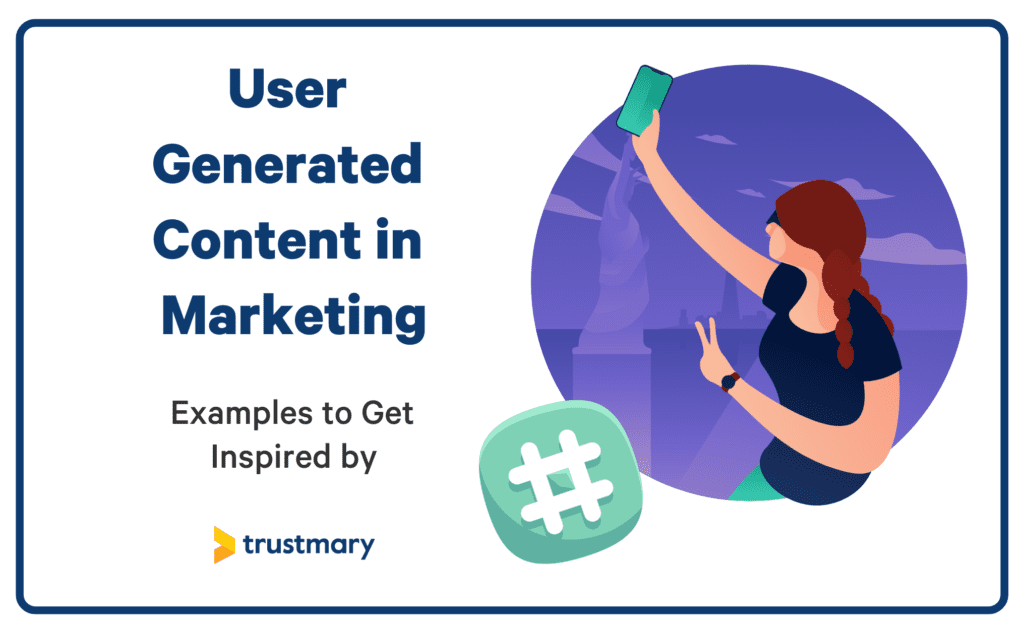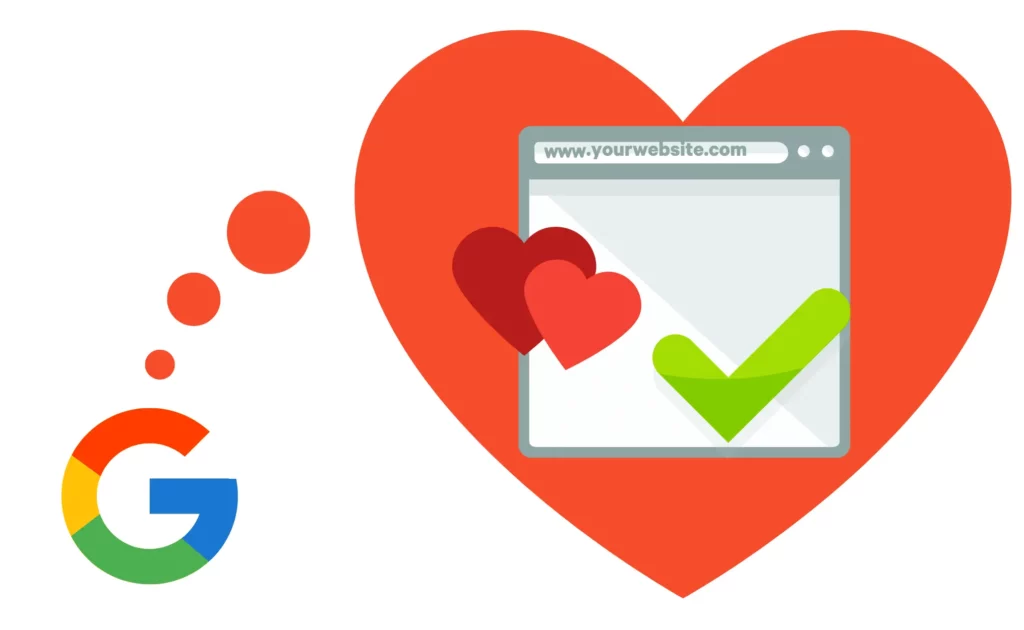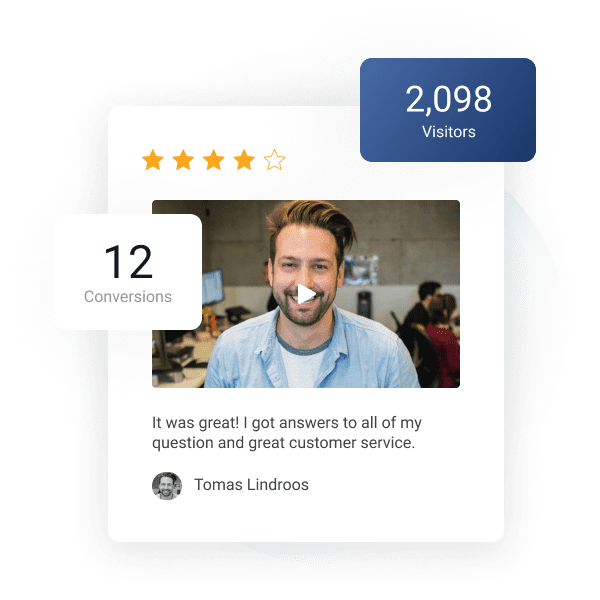Examples of User Generated Content to Get Inspired by

Whether you want to boost conversions or increase brand awareness, you should look into user generated content.
It’s a serious marketing tactic.
Let’s see some examples of user generated content and learn how you can create your own campaigns.
What Is User Generated Content?
User generated content (UGC) means all content created by users and customers about a brand.
It comes in many forms. If a customer writes something, takes a picture, shoots a video, or makes art about and for your brand, that is user generated content.
Things like customer feedback, online reviews, posts on social media channels, participating in a case study and using branded hashtags are examples of user generated content.
UGC is a social proof technique that helps to build trust and credibility for your brand through the wisdom of the crowds.
Examples of User Generated Content
UGC comes in all shapes, forms and sizes.
- Images
- Selfie videos
- Videos
- Blog posts
- Youtube videos
- TikTok videos
- Product reviews
- Reviews on third party reviews sites (Google, Facebook, G2, Capterra, ...)
- Client testimonials
- Video reviews
- Posts about you on any social media platform (IG, Twitter, Facebook, TikTok)
- Instagram stories about your brand
- Using your branded hashtag or tagging your account to their post
In short, anything that is produced by anyone other than your brand about your brand can be classified as UGC.
Benefits of User Generated Content in Marketing
There are many benefits in leveraging user generated content in your marketing strategy.
1. It Is Trusted by Consumers
Consumers trust other customers’ recommendations and opinions more than branded content.
Research shows that
- 60% of customers find new products on Instagram
- 66% purchased from a new brand when they saw a social media post made by another consumer
- 79% of online shoppers say that user generated content is highly impactful for their purchase decisions (compared to branded content (12%) and influencer content (9%))
- 80% would purchase more likely if the new brand showcased content made by real customers on the website
So, UGC is much more effective than advertisements. Although, you can combine the two by using e.g. testimonial ads or ads with UGC video content.
2. Leverage Social Proof
The phenomenon behind the effectiveness of UGC is social proof.
It makes people follow each other’s behavior in new situations. In practice, it means that once we see other people using a product and enjoying it, we want to try it ourselves.
After all, humans love to be part of the pack.
3. Boost your Social Media Algorithms
If you want to get into people’s social media feeds, you need to have users interact with your posts.
This means likes, shares and comments.
The reality is that you will not get that much engagement through social media advertising. User generated images are much more likely to gain traction.
That is the way to greater social media reach and visibility.
4. Build Brand Loyalty
People on social media love to be acknowledged by their favorite brands.
If they publish a picture on their social media channel and you, as a brand, like or comment on it… Bliss for young influencers 😁
This person and all their friends and followers will likely have a positive opinion about you after that.
It is the way to brand loyalty: they will love to buy from you.
5. It Is Affordable
A UGC campaign is generally very cheap to organize. In the best-case scenario, it's virtually free advertising.
It requires some work from the marketing team, and perhaps a small incentive for the participants, but nothing compared to paid advertising.
6. Better SEO Results
There are many ways in which user generated content can boost your website SEO efforts.
- Reviews grow your local search engine rankings.
- On-page SEO increases when you have UGC that includes relevant keywords.
- People stay on your website longer, which Google sees as a positive thing and will reward you with rankings.
- When users link to your website, you get backlinks, which are one of the most important SEO factors.

7. Capture the Voice of Customer
Not only is user generated content important as marketing content, but it also gains you insights into what your customers think about your brand.
In addition to constructive feedback, the positive endorsements can reveal what kind of values the consumers associate with your brand and how they describe it.
Pro tip: even if you are not actively asking customers to provide content, you should still analyze their sentiment. Track your mentions on social media, and capture the true, uncensored voice of the customer.
How to Get User Generated Content?
The right way to get user generated content depends a lot on what kind of business you have.
If you sell tangible consumer products, videos and images of your customers using and endorsing your products is a great way to engage your audience.
However, if you offer services, customer testimonials might be a better form of UGC.
Get creative and read these tips for inspiration!
1. Organize A Contest
What would be more effective for acquiring user generated content than organizing a contest?
Offer great prizes, organize a voting, and remember to give praise for the finalists!
The prize should be accommodated to the effort that the users need to make for the content.
If you are asking for a simple selfie, the prize doesn’t have to be that big. On the other hand, if you are expecting full-blown works of art, you should offer great enough incentive.
Think about what kind of prize would be suitable: money, products, visibility, fame… You name it!
Remember to set clear rules for the competition and really think through how you want to receive the submissions.
- Are you expecting so many entries that your email would clog up with them?
- Will you set up a completely new address for the submissions?
- Would it be better to let people post on their own social media accounts?
- On which social media platform?
- Etc
2. Set Up Your Own Hashtag
If you don’t know yet what hashtag means, here’s a short summary: it is a word that helps you identify and filter content on social media. Yes, it’s marked with that # sign.
For example, if I were to share this blog on social media, I could use #UserGeneratedContent to identify and connect this piece to other similar content.
Whoever would search content with this hashtag, could at some point come across this piece of content.
You can create your own hashtag simply by informing your audience that they should add it into their social media posts.
After that, you can easily find all posts that are identified with the hashtag.
Remember to be specific and mindful about the use of hashtags.
We will see examples of this later on in the blog, so stay tuned!
3. Ask for Testimonials
Reviews and testimonials are an easy way to include your customer’s voice in the marketing strategy.
In testimonials, your satisfied customers tell about their positive experiences with your brand. It can be in written, video, or audio forms.
You might think that getting testimonials is difficult and requires a lot of work. That is out-dated information, my friend!
With a testimonial and feedback survey tool, you can automatically send feedback surveys and testimonial requests to your customers.
You will get marketing permission for the testimonials, so that you can use them publicly.
4. Ask for Users’ Stories
People like to talk about themselves and their experiences.
Ask your audience to share thoughts about an important and emotional topic, relating it to their own experiences.
This strategy is especially useful for NGO’s, or companies that want to address societal issues in their campaigns.
It helps you build your PR and comes across as less salesy.
5. Encourage Video Content by Offering Incentive
Many shopaholics would love to make a review video of products they have purchased.
In fact, “haul” videos are very popular on Youtube. In these videos, users show what they purchased and tell their opinions about the products.
Bigger brands get these videos without asking, simply because consumers love the products.
If you are only starting out, it might be worth it to offer free products to customers in exchange for visibility on their Youtube channels.
Here's an example of how Son de Flor asks for user generated pictures and videos:

How does this differ from influencer marketing, though?
Well, it is a gray area. If you offer products, gift cards, or money in exchange for content, it’s basically paid advertising.

However, there is one big difference between influencer marketing and user generated content: influencers review and use products for living, while regular consumers do not.
6. Make A Case Study
Hello there, B2B folks. I haven’t forgotten about you.
Your clients are very interested in what kind of results their peers have reached with your help.
Showcase these results by making them into a case study. Create both written and visual content that you can use in different contexts.
See tips on making great B2B customer video testimonials.
What Are UGC Reviews?
User-generated content reviews are customer-created testimonials about a product or service.
These reviews are typically shared on social media, websites, or third-party review platforms.
They offer authentic feedback from real users, providing valuable insights into customer experiences.
Unlike traditional marketing, UGC reviews build trust and credibility as they come from unbiased sources.
How to Leverage UGC Reviews?
- Website Integration: Display reviews prominently on your product pages, homepage, or dedicated testimonials section. This increases transparency and trust.
- Social Media Sharing: Regularly share positive reviews on your social media platforms. This not only highlights customer satisfaction but also encourages other customers to share their experiences.
- Email Campaigns: Include customer reviews in your email newsletters to build credibility and influence subscribers.
- Marketing Materials: Incorporate reviews in brochures, ads, and other marketing materials to add authenticity and appeal.
- Video Testimonials: Encourage satisfied customers to create video reviews. These are more engaging and can be shared across various platforms.
How to Use User Generated Content?
You need to figure out a plan for how to use the content in practice.
Here are some ideas.
1. Include on Your Website or Ecommerce Store
When you want to instantly boost conversion rates on your website, include UGC on-page.
→ Add testimonials to your landing page.
→ Showcase a video testimonial on the checkout page, like one of our clients did and increased sales by 32%.
→ Feature user images on product pages, category pages, and create recommendations based on them.
→ Embed social media feeds to your website.
→ Create pop ups with user images and recommendations.
2. Showcase in Newsletters
Impress the marketing qualified leads with UGC from other people who have already purchased from you.
Include case studies, showcase testimonials, and accompany discounts with user images.
And, of course, announce the winners of a UGC content competition!
3. Share on Your Social Media Platforms
Share photos of your customers on your own social channels (if you have permission to do so).
For the best reach, share social media content on various channels. For example, if you get submissions on Instagram, why not move the best ones to other social media platforms, too?
It’s no surprise, though, that Instagram is probably the most popular social media platform for UGC. Visual content just works so well!
4. Build A Community
Create your own groups, blogs, or even your own social platform or mobile application where people can add their own content, interact with others, and share tips.
Don’t forget to be an active participant in the community yourself. React to users’ content and thus encourage participation.
Regardless of format, if you are able to form a community in which people see your products as a lifestyle choice, you can get basically unlimited re-purchases and long term customers.
Truly engaged customers wouldn’t even consider buying similar products and services from somewhere else!
5. Users as Models
One thing that advertising receives criticism for, is unrealistic and overly edited pictures. People want to see how e.g. clothes fit “an average body” rather than supermodels.
Offer your customers a chance to be their own models! Ask them to use your products and snap a picture of themselves:
“Share your outfit!”
“Show us how this makeup product looks on you!”
“Tell us in pictures or video how your hunting trip went using our products!”
After you receive these images and videos, you can use interactive content tools to create click-and-buy images.
It's the future of social shopping and online shopping. Tap in now!
Examples of User Generated Content in Marketing
We have now seen lots of UGC ideas, but how about the real life examples?
You shall receive!
Here are 7 examples of user generated content campaigns from real businesses.
1. Acon
The trampoline and sports equipment company Acon features customers’ videos on their Instagram.
The brand launched a campaign in which people can share their own daring sports moments.
People can submit content by using the hashtag #beathrillseeker when they publish on Instagram.
The company can find the content that way and feature it on their account.
It has all been explained in the company’s profile!
2. GoPro
GoPro is a company that sells all kinds of equipment for photography and videography.
Challenges are a big part of their marketing strategy. Even today, they have three different challenges running that the customers can participate in and win prizes.
Rules and instructions are clearly defined on a separate page.
To be honest… the results are amazing! But not for the squeamish 🤭
Check out this daredevil from a past challenge:
3. Fazer x Novita
Recently, two Finnish brands joined forces and organized a knitting competition.
People were asked to design their own socks using the yarn by Novita, and as an inspiration they had to use the different candies that Fazer produces.
The winning designs were included in the special magazine number.
I was amazed when looking at the results of the competition. As a fellow knitting enthusiast, I want to make them all!
4. Lululemon
This is a great example of Try On Haul -video on Youtube. In the video, a girl tries on the clothes she has purchased from Lululemon.
One gets the idea that Lululemon is not sponsoring the content creator, yet she puts a lot of effort into the videos. That speaks loudly about brand loyalty!
Check out what one of the commenters say:
“I love these vids. Every time I watch them I have a separate lulu tab open to browse all the products”
Clearly, the video really works, as people are considering buying the same products.
5. World Vision 40 Hour Famine
World Vision organized a 40 Hour Famine campaign to raise awareness about the shortage of clean water around the world.
The idea of the campaign was to execute a challenge that includes 40 something: 40 hours, 40 miles, and so on. The challenge was simultaneously a fundraising campaign.
People could share their own challenge with the hashtag #40hfnz.
Check out this college football team who played 40 hours of football:
6. Chipotle
The restaurant chain Chipotle organized a TikTok challenge called #ChipotleLidFlip.
Like the name states, the participants try to flip a foil lid on top of their plate. The videos are shared on TikTok with the branded hashtag.
See videos here.
Videos marked with the hashtag have over 300 Million views.
However, this number is a little bit misleading, as not all videos counted include the actual challenge. Many TikTok users are involved in the dark side of hashtags: hashtag spamming.
People add popular hashtags to their videos in order to get views, even when the video has nothing to do with the original context.
This leads to a situation where searching with a specific hashtag doesn’t actually filter the desired content.
7. Windward Software
Windward Software features customer reviews and testimonials on their own website.
If interested potential customers were to browse their website, these testimonials by existing customers would instantly increase trust for the company.
The fact that the reviews have full names and sometimes profile pictures of real people boosts the effectiveness.
Since the reviews are showcased with a dynamic widget, it adds a wow factor to the website and truly catches the attention of visitors.
Practical Tips for Launching a User Generated Content Campaign
1. Make It Easy
If submitting content is complicated and difficult, you can’t expect people to do it.
Offer your customers enough information about what you are asking them to do, and make it as easy as possible for them.
Send emails for your customers, and tell about your wishes for UGC on your website and social media.
Provide easy to use submission forms and direct links to correct pages.
2. Clear Instructions
Remember to be very clear with the instructions.
Especially if you are organizing a competition and offering prizes, you should try to ensure that people can’t “hack the system” or be disappointed because they were not qualified for the contest.
State that only one submission per person is allowed, tell what kind of content you are looking for, what are the criteria for a winner, who chooses the winner, and all that jazz.
Even when there is no competition, be clear about where and how people can submit their content.
3. Check the Legal Stuff
If you do giveaways, prizes, collect user data, use the content in marketing, and so on, you need to be sure that everything is okay legally.
Check with your own country, state, province or municipality regulations to avoid any trouble in the long run.
Additionally, make sure that the users give you marketing permission. It would be not at all fresh to use someone’s content without permission.
4. Create A GOOD Hashtag
There is a lot of discussion around whether hashtags work or not.
My opinion: they are excellent for this purpose if they are well planned and purposeful.
What makes a good hashtag?
It needs to be unique in order to separate the content from irrelevant noise. If you choose a generic hashtag that has millions of posts, there’s no chance to identify your customers’ posts.
Remember to research the hashtags a little bit. When you get an idea, check if it has been used before.
It’s unlikely that your hashtag will become super viral, but in case that happens, be prepared for lots of spam.
If you are out of ideas, see Attrock's list and choose the right hashtag generator software to help you with the task.
5. Align with Your Values
Last but not least (in fact, it is one of the most important things to think about): make sure that the user generated content campaign is aligned with your company’s values.
The content must support your marketing strategy and company image.
Think about what is the angle that gets relevant user generated content for your company. Refer to the above real life examples and reflect how they have done things.
Sure, if you sell clothes, the relevant angle is to collect user images of wearing those clothes.
If you sell services, customer testimonials and endorsements are great!
6. Analyze the Results
An UGC campaign is essentially just one of your marketing campaigns.
Make sure to set up tracking before even launching it in your social media channels. After all, if you don't know what your results were, how can you estimate your ROI?
Naturally, it's more difficult to track the development of your brand identity than to track conversion rates. Try tracking the following metrics to measure whether a UGC campaign was a success:
- Likes
- Comments
- Shares
- Like to comment ratios
- Views
Conclusion on User Generated Content
We saw what benefits UGC has, how you can get it and use it, what kind of UGC campaigns brands have run, and learned some practical tips for launching your own campaign.
In order to get consumer generated content, you need to clearly communicate the wishes and sometimes offer incentives. Competitions and challenges are a great way to get content.
Remember to always align the user generated content campaigns with your company values and image. It needs to be a seamless part of your marketing strategy.
The Easiest Way to Collect Effective UGC
The easiest way to start collecting user generated content is to ask for customer feedback and testimonials.
It is easy with Trustmary’s feedback surveys and testimonial request forms. You can also get video testimonials that are even more effective.
Showcase the testimonials on your website with dynamic widgets, and browse other social proof elements that you can use.
Hopefully this blog helped you understand the concept of user generated content, and gives you tools to launch your own campaign!
Further Reading
- The Definitive Guide for Understanding the Power of Social Proof
- Want to Increase Customer Loyalty? Build a Community, Avoid Rewards
- Social Media Marketing Basics – How Do You Get The Most Out Of A Social media?
- 5 Tips for Instagram Marketing
FAQ
What is user generated content?
User generated content (UGC) means all content created by users and customers about a brand. It can be e.g. images, videos, text, or art work that is shared online.
How to make a user generated content campaign?
To launch your own UGC campaign, you need to
- plan a great theme for content creation
- set rules and instructions
- communicate with your customers and
- keep rewarding people for doing it.
The reward can be a feature on your own social media, or even monetary prizes.
What are some examples of user generated content?
Some examples of UGC include
- sharing pictures of products on social media
- using branded hashtags
- participating in challenges and sharing it online
- writing customer reviews and testimonials
- submitting an entry to a competition and
- filming a video about a set theme
What benefits user generated content has?
Using UGC in your marketing efforts has many benefits: it builds trust for your brand, leverages social proof, boosts social media visibility, increases brand loyalty, boosts SEO efforts, helps you learn more about your audience, and is cost effective.
